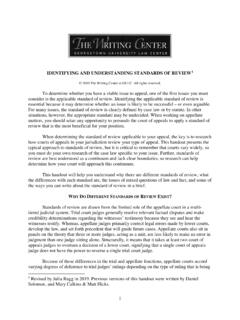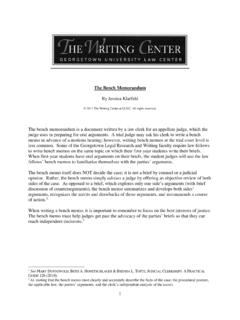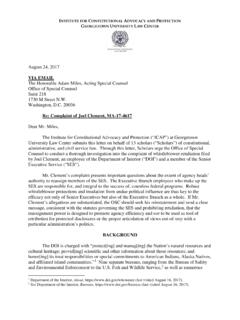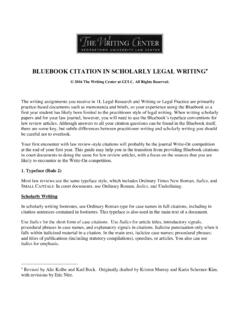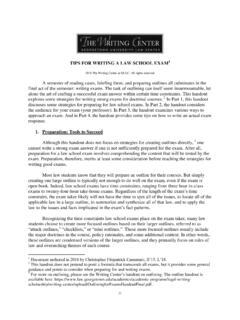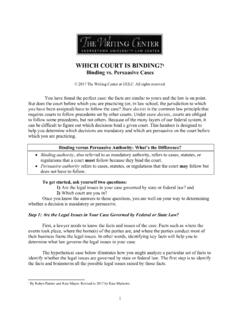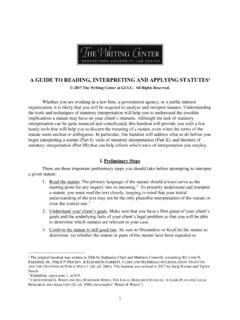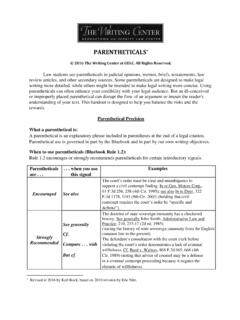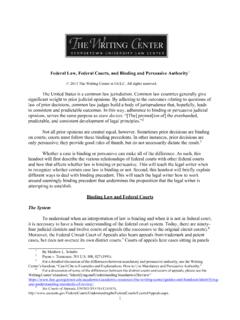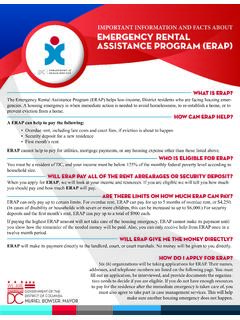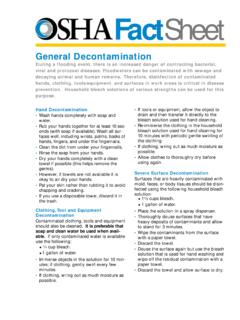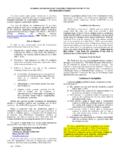Transcription of From Memo to Appellate Brief - Georgetown University
1 FROM MEMO TO Appellate Brief . 2004 The Writing Center at GULC. All rights reserved. Osamudia Guobadia and Jennifer Pogue, Edited by Kala Sherman-Presser (2009) and Katie Wallat (2012). Now that you're getting comfortable with the art of memo-writing, it is time to switch gears and learn how to write a Brief . This transition may seem overwhelming at first, but briefs and memos actually have more in common than you might initially think. Almost all the skills that you have learned your first semester, including legal research, case analysis, and organization, apply to both memos and briefs. This handout will provide you with some basic comparisons between memo and Brief writing, and help to ease your transition from objective to persuasive writing.
2 As you know, the purpose of a memo is to answer a legal question, and your role as its writer is to objectively research and predict the answer. A Brief , on the other hand, is written to persuade the reader that one position on the issue is the correct one. Additionally, while a memo is written for another attorney or for a client, a Brief is written for the judge(s) deciding your case and your opposing counsel. Accordingly, your job is not only to recommend action, but to persuade the court to take the action your client desires. The chart below provides a comparison of how these elements change when you move from memo to Appellate Brief . DIFFERENCES IN PURPOSE, AUDIENCE, AND SCOPE1. MEMO Brief . Purpose: Primarily to answer a legal question about Purpose: Inform AND persuade the reader that your what the likely outcome will be when the law is application of the law to the facts is the correct one.
3 Applied to a particular set of facts. Emphasize favorable arguments and minimize the force of Objectively inform the reader about what the law opposing arguments. is so she can make an informed decision. Win the case, using the law in the way most favorable to Develop a legal strategy with other attorneys. your client. Audience: Primarily another lawyer in your firm or Audience: Primarily the Appellate judge(s) who will decide organization; also often your client. your case, as well as their clerks; opposing counsel; your client. Scope: Generally the scope of the memo is laid out Scope: Generally speaking, you should strive to include all the for you by your supervising attorney. relevant arguments that prove your client should prevail.
4 You may be constrained by the specific question Stick to the issues the judge (or professor) has asked you to or other financial/ constraints. Brief , or the ones that are of central importance to the case. Because memos form the basis for legal decisions, You may be constrained by a word limit or other be honest about the strengths and weaknesses of financial/time constraints. your client's case and what the law does and Also note that the standard of review may influence the does not allow before giving advice. scope of the Brief (see further discussion below). 1. For further information on the purpose, audience, and scope, consult: Mary Barnard Ray and Jill Ramsfield, Legal Writing: Getting it Right and Getting it Written, 57, 219-21 (3d ed.)
5 2000) and Linda Edwards, Legal Writing and Analysis, 127, 162- 64(2d ed. 2007). 1. In addition to differences in purpose, audience, and scope, the Brief and memo also have slightly different components. You are already familiar with the primary components of a memo. Although the exact format and content of a Brief may vary slightly in each jurisdiction, the body of the Brief usually contains four main parts that are similar to those in the memo: the Statement of the Issues Presented for Review, the Statement of the Facts or Statement of the Case, the Argument, and the Conclusion. Most courts will also require a Table of Contents and Table of Authorities, as well as a Summary of the Argument and a Standard of Review. Always remember to refer to your court's rules (or your professor's requirements) for specific requirements.
6 The chart below compares the main components of the memo and Brief . COMPARING COMPONENTS OF THE MEMO AND BRIEF2. MEMO Brief . Question(s) Presented: Presents an Statement of Issue(s) Presented for Review (the Issue objective statement of the legal questions to Statement ): Identifies and describes the legal issue(s), be answered in the memo, the crux of what invokes the applicable law, describes the most legally you're writing about. significant facts. Includes 3 elements: the jurisdiction, the Differs from the Question Presented in point of view, as it legal issue, and the most legally is persuasive. An effective Issue Statement should suggest significant facts. an outcome, using the relevant facts and the applicable law to elicit an answer that affirms the analytical reasoning of the Brief .
7 Brief Answer: Provides a short answer to Summary of the Argument:3 A statement that previews the the question(s) presented. major conclusions in your Brief and the reasons supporting Usually includes a Brief explanation of the those conclusions. legal basis for that answer, including some This section does not usually include formal citations or of the main legal elements or buzzwords. quotations, but is still specific to the client's case under Generally, there are no formal citations or review. quotations in this section. Should be self-contained so that a busy reader could read only this section and still understand the essence of your argument. Your Theory of the Case (discussed below) should be apparent in your Summary of Argument.
8 Standard of Review:4 The level of deference the reviewing [The Standard of Review is not typically court must give to the lower court's decision. included in memos.] Includes citation to cases that use the appropriate standard. See further discussion below, on page 5. 2. For further discussion on all of these elements, consult: John C. Dernbach, Richard V. Singleton, A Practical Guide to Legal Writing& Legal Method, 18791, 21524 (2d ed. 1994) Mary Barnard Ray and Jill J. Ramsfield, Legal Writing: Getting it Right and Getting it Written, 24, 56, 62-63, 92-93, 174-76, 184-88, 289-90, 358-60, 364 (3d ed. 2000); Kristen Robbins-Tiscione, Rhetoric for Legal Writers, 216-25, 237-54 (2009). 3. A Summary of Argument should contain a succinct, clear, and accurate statement of the arguments made in the body of the Brief and not merely repeat the argument headings.
9 Fed. R. App. P. 28(a)(8). 4. For further discussion on Standards of Review, see the Writing Center handout, Identifying and Understanding Standards of Review.. 2. MEMO Brief . Statement of the Facts: An objective and Statement of the Case: A short section describing the complete description of the legally procedural history of the case, including the nature of the case significant facts relevant to the discussion ( civil or criminal, tort or contract), the history of the section. proceedings, and disposition below. Keep in mind that if you use a fact in your Some courts require a separate Statement of the Case;. analysis section, it should also appear in others expect this information to appear within your your Statement of Facts.
10 Statement of Facts or in the Argument section. Again, The beginning or end of this section always consult the court's rules or your professor's typically includes procedural history of requirements for specific guidelines. the case (to the extent there is any), and Statement of the Facts: An account of the facts of the case what the client hopes to achieve. as told from your client's perspective [The Statement of the Case is not typically Should seek to make the court sympathetic to your client included as a separate section in memos. by emphasizing the favorable facts and downplaying the While the procedural history is very unfavorable ones, without dishonestly omitting important important in Appellate briefs, it is often legal facts.]
